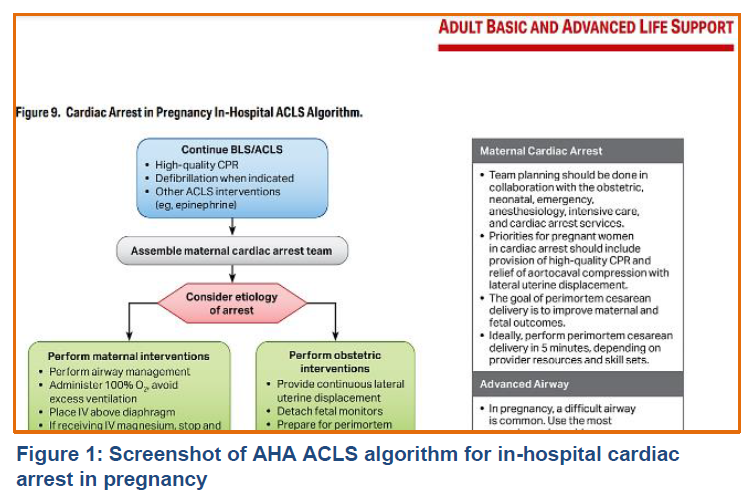Behnam Farahmandnia 1, Asad Imani 2*
Author affiliations:
Key words: Pregnant, Women, Resuscitation
Citation: Farahmandnia B, Imani A. Necessity of a change in AHA CPR guidelines 2020 for pregnant women (Correspondence). Anaesth. pain intensive care 2021;25(3):408–409.
DOI: 10.35975/apic.v25i3.1504
 .
.
CPR in pregnant women is different from non–pregnant women in many aspects. A uterus that extends to the umbilicus is usually sufficiently large to cause aortocaval compression (ACC).1 ACC occurs when the gravid uterus compresses the maternal abdominal aorta and the inferior vena cava (IVC).2,3 For prevention of ACC, left lateral uterine displacement must be done in CPR process, as it has been confirmed by a large number of evidence basedCardiopulmonary resuscitation (CPR) guideline have been revised every five years according to the current evidenced-based findings. Changes are focused on high quality CPR, healthcare workers, time restrictions, equipment’s and unique situations. CPR in pregnant women undergoing CPR for cardiac arrest, is one of the most important situations that must be paid due attention to it in the new guidelines. studies to provide total relief of ACC.4 In the new CPR guidelines, published by American Heart Association (AHA) in 2020, it is declared that relief of ACC with lateral uterine displacement is not related to the gestational age (Figure 1).5 Although, they have specified it for in-hospital cardiac arrest.
The fact is that ACC occurs typically after 20 weeks gestation.6,7 Before 20 weeks gestational age, the fundus can be palpable below the level of umbilicus. Our assumption is that lateral uterine displacement is not necessary before 20 weeks gestational age due to uterus placement and the relatively smaller size. In this position, a rescuer has been withdrawn from participating of chest compression or airway management as two important components of CPR process. It seems that new CPR guidelines in pregnant women must be written according to gestational age (e.g. before 20 weeks and after 20 weeks). We recommend that our assumption is examined on hemodynamic outcomes of pregnant women during CPR in future studies.
References
Author affiliations:
- School of Nursing and Midwifery, Dezful University of Medical Sciences, Dezful, Iran.
- Department of Nursing, Faculty of Nursing and Midwifery, Ilam University of Medical Sciences, Ilam, Iran.
Key words: Pregnant, Women, Resuscitation
Citation: Farahmandnia B, Imani A. Necessity of a change in AHA CPR guidelines 2020 for pregnant women (Correspondence). Anaesth. pain intensive care 2021;25(3):408–409.
DOI: 10.35975/apic.v25i3.1504
 .
.CPR in pregnant women is different from non–pregnant women in many aspects. A uterus that extends to the umbilicus is usually sufficiently large to cause aortocaval compression (ACC).1 ACC occurs when the gravid uterus compresses the maternal abdominal aorta and the inferior vena cava (IVC).2,3 For prevention of ACC, left lateral uterine displacement must be done in CPR process, as it has been confirmed by a large number of evidence basedCardiopulmonary resuscitation (CPR) guideline have been revised every five years according to the current evidenced-based findings. Changes are focused on high quality CPR, healthcare workers, time restrictions, equipment’s and unique situations. CPR in pregnant women undergoing CPR for cardiac arrest, is one of the most important situations that must be paid due attention to it in the new guidelines. studies to provide total relief of ACC.4 In the new CPR guidelines, published by American Heart Association (AHA) in 2020, it is declared that relief of ACC with lateral uterine displacement is not related to the gestational age (Figure 1).5 Although, they have specified it for in-hospital cardiac arrest.
The fact is that ACC occurs typically after 20 weeks gestation.6,7 Before 20 weeks gestational age, the fundus can be palpable below the level of umbilicus. Our assumption is that lateral uterine displacement is not necessary before 20 weeks gestational age due to uterus placement and the relatively smaller size. In this position, a rescuer has been withdrawn from participating of chest compression or airway management as two important components of CPR process. It seems that new CPR guidelines in pregnant women must be written according to gestational age (e.g. before 20 weeks and after 20 weeks). We recommend that our assumption is examined on hemodynamic outcomes of pregnant women during CPR in future studies.
References
- Guedes-Martins L, Graça H, Saraiva JP, Guedes L, Gaio R, Cerdeira AS, et al. The effects of spinal anaesthesia for elective caesarean section on uterine and umbilical arterial pulsatility indexes in normotensive and chronic hypertensive pregnant women: a prospective, longitudinal study. BMC Pregnancy and Childbirth. 2014;14(1):291.[PubMed] DOI: 10.1186/1471-2393-14-291
- Humphries A, Mirjalili SA, Tarr GP, Thompson JMD, Stone P. Hemodynamic changes in women with symptoms of supine hypotensive syndrome. Acta Obstet Gynecol Scand. 2020 May;99(5):631-636. [PubMed] DOI: 10.1111/aogs.13789
- Zelop CM, Einav S, Mhyre JM, Martin S. Cardiac arrest during pregnancy: ongoing clinical conundrum. American Journal of Obstetrics and Gynecology. 2018;219(1):52-61. [PubMed] DOI: 10.1016/j.ajog.2017.12.232
- Lavecchia M, Abenhaim HA. Cardiopulmonary resuscitation of pregnant women in the emergency department. Resuscitation. 2015;91:104-7. [PubMed] DOI: 10.1016/j.resuscitation.2015.01.017
- Craig-Brangan KJ, Day MP. Update: AHA guidelines for CPR and emergency cardiovascular care. Nursing 2020. 2020;50(6):58-61. [PubMed] DOI: 10.1097/01.NURSE.0000659320.66070.a9
- Oates S, Williams G, Rees G. Cardiopulmonary resuscitation in late pregnancy. BMJ 1988;297(6645):404. [PubMed] DOI: 10.1136/bmj.297.6645.404
- Logan JK, Pantle H, Huiras P, Bessman E, Bright L. Evidence-based diagnosis and thrombolytic treatment of cardiac arrest or periarrest due to suspected pulmonary embolism. Am J Emerg Med. 2014 Jul;32(7):789-96.. [PubMed] DOI: 10.1016/j.ajem.2014.04.032